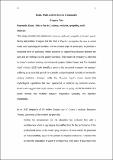Files in this item
Keats, myth, and the science of sympathy
Item metadata
| dc.contributor.author | Tate, Gregory Paul | |
| dc.date.accessioned | 2016-07-07T13:30:08Z | |
| dc.date.available | 2016-07-07T13:30:08Z | |
| dc.date.issued | 2016-07 | |
| dc.identifier | 243606653 | |
| dc.identifier | 20d9c5d4-af6c-44e4-9b74-3d485c519a3f | |
| dc.identifier | 84975833317 | |
| dc.identifier | 000378568400005 | |
| dc.identifier.citation | Tate , G P 2016 , ' Keats, myth, and the science of sympathy ' , Romanticism , vol. 22 , no. 2 , pp. 191-202 . https://doi.org/10.3366/rom.2016.0274 | en |
| dc.identifier.issn | 1354-991X | |
| dc.identifier.other | ORCID: /0000-0002-5930-8187/work/60631343 | |
| dc.identifier.uri | https://hdl.handle.net/10023/9086 | |
| dc.description.abstract | This essay considers the connections between myth and sympathy in Keats’s poetic theory and practice. It argues that the ‘Ode to Psyche’ exemplifies the way in which Keats uses mythological narrative, and the related trope of apostrophe, to promote a restrained form of sympathy, which preserves an objectifying distance between the poet and the feelings that his poetry examines. This model of sympathy is informed by Keats’s medical training: the influential surgeon Astley Cooper and The Hospital Pupil’s Guide (1816) both identify a sensitive but restrained sympathy for patients’ suffering as an essential part of the scientific and professional methods of nineteenth-century medicine. However, while The Hospital Pupil’s Guide claims that mythological superstition has been superseded in medicine by positivist science, Keats’s ode suggests that myth retains a central role in poetry, as the foundation of a poetic method that mediates between imaginative sympathy and objective impartiality. | |
| dc.format.extent | 12 | |
| dc.format.extent | 396331 | |
| dc.language.iso | eng | |
| dc.relation.ispartof | Romanticism | en |
| dc.subject | Keats | en |
| dc.subject | Science | en |
| dc.subject | Poetry | en |
| dc.subject | Medicine | en |
| dc.subject | Sympathy | en |
| dc.subject | Myth | en |
| dc.subject | PN Literature (General) | en |
| dc.subject.lcc | PN | en |
| dc.title | Keats, myth, and the science of sympathy | en |
| dc.type | Journal article | en |
| dc.contributor.institution | University of St Andrews. School of English | en |
| dc.identifier.doi | 10.3366/rom.2016.0274 | |
| dc.description.status | Peer reviewed | en |
This item appears in the following Collection(s)
Items in the St Andrews Research Repository are protected by copyright, with all rights reserved, unless otherwise indicated.

